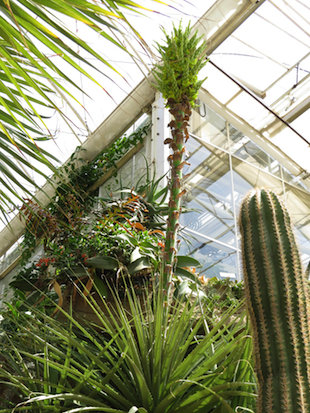当前位置: Language Tips> 双语新闻
Feed me, Seymour: ‘Sheep-eating’ plant blooms in the U.K.

|
A towering South American plant that is believed to kill animals with its spikes and use their decaying bodies as fertilizer is about to bloom in England. A rare Puya chilensis was planted at a greenhouse in Surrey about 15 years ago. However, despite its intimidating description, the tall, spiked plant is considered a threatened species. The Royal Horticultural Society at Wisley has been feeding the plant a diet of liquid fertilizer. “In its natural habitat in the Andes it uses its razor sharp spines to snare and trap sheep and other animals, which slowly starve to death and decay at the base of the plant, providing it with the grizzly equivalent of a bag of fertiliser,” reads a description on the RHS website, which adds that the plant emits a “gruesome scent.” But does the plant actually trap and eat sheep? Other sources have simply said it is “believed” that the plant traps small animals with its spikes. After the animals die of starvation, the plant is "believed" to then use their decaying bodies as fertilizer to feed itself. "I'm really pleased that we've finally coaxed our Puya chilensis into flower," horticulturalist Cara Smith said in a press release on the RHS site. Regardless of whether it actually traps sheep, the plant does have sharp spikes that can grow up to 12 feet high and 5 feet wide. However, it’s not all death and danger for this plant. Its flowery blooms reportedly provide nectar for bees and birds. The Puya chilensis blooms annually in its native land of Chile, but this is the first time it has done so after more than a decade of cultivation efforts from the RHS. "We keep it well fed with liquid fertiliser as feeding it on its natural diet might prove a bit problematic,” Smith said. "It's growing in the arid section of our glasshouse with its deadly spines well out of reach of both children and sheep alike." |
据美国雅虎新闻网6月21日报道,日前,英国皇家园艺协会从南美洲引进的“食羊植物”智利普亚菠萝在该协会位于萨里郡的温室中生活了15年之后,终于成功开花。 智利普亚菠萝是一种生活在智利的高大植物,最大能够长到12英尺(约为3.66米)高、5英尺(约为1.52米)宽。它不仅有庞大的体积,而且体表长满极其锋利的尖刺,有人说它能够靠这些尖刺来捕获羊等动物。“食羊植物”这一称呼正是来自于这种说法。 皇家园艺协会在其网站上对普亚菠萝这种令人可怕的特性进行介绍,称这种植物周身散发着“恐怖的气息”,“在位于南美安第斯山脉的自然栖息地里,它体表长有的锋利尖刺能够困住羊等动物,这些动物会被活活饿死,并慢慢腐烂,然后成为它的天然肥料”。 据悉,在“老家”智利,普亚菠萝每年开花一次,但在引入英国后,这还是它首次开花。 园艺家卡拉·史密斯表示:“我们精心照料它,用液体肥料浇灌……我们把它种植在温室的干燥区域,并且要避免孩子们和羊等动物靠近它。” 相关阅读 (翻译:变色龙 编辑:Julie) |
上一篇 : 希拉里:我希望看到一位美国女总统上任
下一篇 : 科学家绘制出3D人脑高清模型
电话:8610-84883645
传真:8610-84883500
Email: languagetips@chinadaily.com.cn